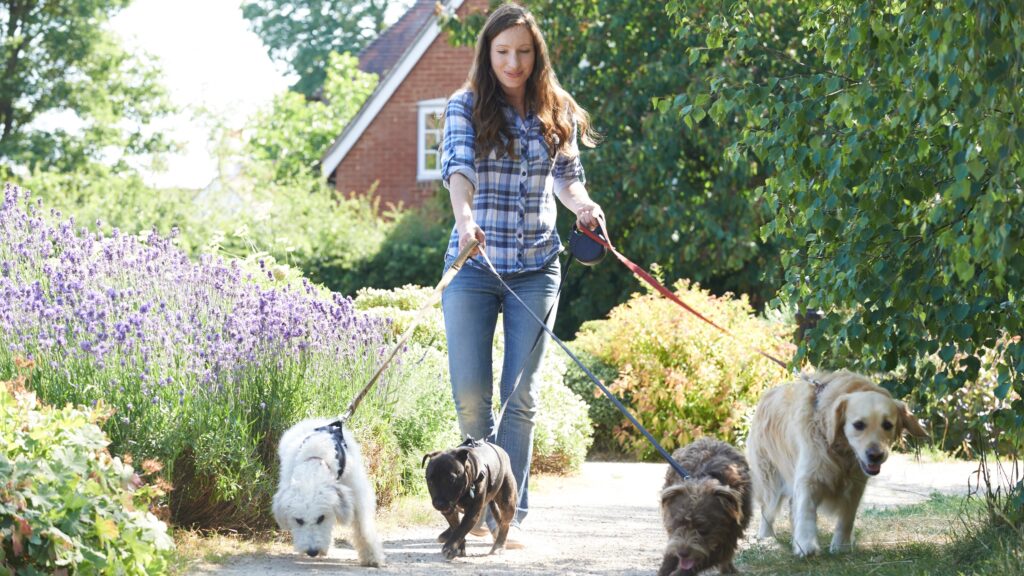Two years on from the start of the pandemic and several things have become clear. Working from home is now a permanent arrangement and not going away. People are going abroad on holiday less frequently. Doing exercise over a video link is normal (in fact, anything digital is only going to accelerate, so social media, which can pinpoint buyers, cements its place as the #1 marketing tool). And the green revolution, whether it’s upgrading your car to a fully electric vehicle or installing a heat pump when it comes to replacing your boiler when it conks out will be a choice for hundreds of thousands of households.
These six best small business ideas for 2022 reflect current trends, while building on our existing 5 best ideas to start a business post coronavirus feature.
Yoga teacher

Yoga, once considered a kooky, hippie-ish, lentil-eating fitness fad, went thoroughly mainstream during lockdown with yoga teacher Adrienne Mishler’s videos on YouTube being watched 300 million times between March 2020 and March 2021. Her YouTube channel has nearly 11m subscribers, while her yoga videos have been watched an astonishing billion times in total.
Of course, your own career as a yoga teacher doesn’t have to go that stratospheric. For many people, it’s a side hustle to have alongside their day job. My yoga teacher, for example, also worked in an optician. But she still ran her yoga teaching as a business, which meant having an accountant and taking out insurance.
In the last year, the number of people searching for “yoga teacher training” skyrocketed – increasing by more than 500 per cent. Since 2018 Yoga Alliance Professionals, the UK’s leading professional body for yoga teachers and trainers, has experienced 41 per cent growth in the number of registered providers offering yoga teacher training.
Once Covid hit, all yoga practice went online, which suited some teachers but not others.
Bruce Mackay, co-founder of YAP, says: “Since Covid the whole world is used to doing things online. Even my parents are used to going on Zoom, which means it’s a global market.”
And, given the mental health and obesity problems people suffered during lockdown, there’s more need than ever for a fitness practice which requires minimal equipment you can do at home.
How long does it take to become a yoga teacher in the UK?
To teach yoga you’ll need to complete a 200-hour foundation yoga teacher training course. While there is no set syllabus, this should cover asana (postures), meditation, pranayama (breathing exercises), the philosophy of yoga, anatomy, physiology, and how to teach.
If you’re looking at a college course in the UK, you could complete a qualification such as:
- Level 3 Diploma in Teaching Yoga
- Level 4 Diploma in Teaching Yoga
You can become an accredited yoga teacher either through YAP or the long-established British Wheel of Yoga (BWY).
Your next big decision will be whether to go for an intensive training course (around three to four weeks) or long-term training, typically spread over 12 months.
While the former is an attractive option for those of us who have little free time, one-month intensive courses are often gruelling, with roughly 10 hours a day spent on the yoga mat.
Non-intensive courses, on the other hand, require attendance on weekends and sometimes include one or two-week mini-intensive sessions. However, the benefit of a non-intensive course is that it allows you to absorb what you have learnt and bring it into your own practice.
With experience you might choose to specialise further by completing a pregnancy yoga teacher training or children’s yoga, for example.
Yoga Alliance Professionals offers six specialised courses in sports yoga, children’s yoga, teen yoga, mindfulness and meditation, ayurvedic yoga and Thai massage.
You could also go on to complete 300-hour and 500-hour teacher training. Yoga Alliance Professionals, the body for professional yoga teachers, requires all yoga trainers to have at least eight years of teaching and training post-foundation.
What qualifications do you need?
To start with, anybody thinking of becoming a yoga teacher needs to have been practising yoga for at least two years for five or six days a week.
The starting point for teacher training is 200 hours under physical supervision, at the end of which you will be certified in whichever type of yoga you follow, from soft hatha to fast-moving ashtanga.
Before enrolling on a yoga teacher training course, you should be an established yogi yourself with a good grasp of the more complex poses. Indeed, many training schools will scrutinise their students’ practice to ensure it passes muster before signing up for a foundation course.
How much does it cost to set up as a yoga teacher?
The beauty of yoga is that all you really need is a mat, a tee shirt and some shorts. That’s it. You don’t even need those expensive Lululemon leggings. You can start by giving friends a yoga lesson in your own home and then you branch out, renting a space in a community hall for group sessions, for example.
The easiest way to get experience as a yoga teacher once you are certificated is to cover classes at gyms, whose high turnover in teachers means gaps in class schedules.
Do I need to have professional indemnity insurance?
Yoga Alliance Professionals offers a £6m personal indemnity insurance package through Zurich, which any gym or yoga studio would insist on.
How much will I earn?
Right from the start, you must decide if you are becoming a yoga teacher as a hobby or if you want to run your own business.
Yoga teachers charge between £8 and £15 per class nationwide, with higher rates in London.
However, you can only make a decent living as a full-time yoga teacher once you have more experience and can offer developmental workshops for more in-depth training or inhouse classes for businesses.
According to the National Careers Service, a beginner yoga teacher will earn £18,000 per year and an experienced one, £25,000.
If you’re employed by a gym, you can expect to earn between £20 and £30 per hour. If you decide to go self-employed, you can charge anywhere between £5 and £15 per person for group sessions or between £35 and £60 for private classes.
>See also: Five business ideas that are bound to click
Heat pump installer

Setting up on your own as a qualified heat pump installer could be one of the smartest set-up-your-own-small-business decisions you make. Research and consulting services company Delta-EE forecasts that by 2025 the UK heat pump market will already have doubled in size. As wasteful and polluting gas boilers are phased out, the Government wants 600,000 heat pumps to be installed in the UK each year from 2028. And, because the Government’s ambitious target, it is estimated that the heating industry is between four and five years away from meeting demand.
What is a heat pump?
In simple terms, an electric heat pump works like a reverse fridge, extracting warmth from the outside air, the ground or a nearby water source before concentrating the heat and transferring it indoors. They can usually be found outside a home, where they look like a standard air-conditioning unit.
Air source heat pumps are relatively simple to install for a qualified installer. The pipework and heat pump controls layout are not dissimilar to those of a conventional oil or gas boiler — i.e. a heat generator, cylinder, pipework, heat emitters, and controls — which can make installation a much less complicated process.
Shortage of heat-pump installers
Currently, there are only 2,000 heat pump installers throughout the UK compared to 100,000 regular gas boiler engineers. Indeed, between 2014 and 2017, the number of accredited heat pump installers fell by 65 per cent. The Chartered Institute of Plumbing and Heating Engineering (Ciphe) estimates the industry needs to retrain 100,000 heating engineers in low-carbon technologies.
What qualifications are required to install heat pumps?
At present, there are two routes you can go down.
Either you apply directly to a heat pump manufacturer such as Vaillant or Worcester Bosch, which run their own courses.
Jerry Whiteley, technical manager at Ciphe, says: “Manufacturers are doing a great job in running their own training courses.”
Or you go through standard certification as a gas and heating engineer through the nationwide Level 2 NVQ, which you can do within one year. Once you have gained your Level 2 or Level 3 NVQ, you can then specialise as a heat pump engineer as an add-on.
Ideally, you would also work as an apprentice alongside the working domestic heating engineer while taking your NVQ.
Whiteley says: “To keep up with this new technology you need to understand a lot more than just heat pumps. An installer had to fully understand heating and hot water.”
The good news is that a specific Government-funded training apprenticeship for renewable low-carbon technology, and specifically heat pumps, will be launched in September 2022.
Accreditation bodies including LCL Awards and Bpec are also preparing heat pump installation courses, with City & Guilds expected to follow suit.
So if you are already a heating installer, you could very well undertake more training to install heat pumps and set up a new business in 2022, but if you are completely new to the industry, you will have to get years of training under your belt first.
How much will I earn?
As a qualified heating engineer you can expect earn a minimum of £50,000 a year self-employed. If you work for a boiler manufacturer, you can earn anything between £30,000 and £40,000 a year. Plus you earn more if you’re working in Greater London.
And, if you are a specialist heat pump engineer, you could earn even more, given the shortage in qualified installers.
Driving instructor

Only electric cars will be available to buy in Britain from 2035. There are already 300,000 fully electric cars on the road in the UK and 600,000 plug-in hybrids, and take-up is accelerating.
However, you still need to be able to drive an electric car, even if “it nearly drives itself”, as one Tesla owner enthused to me.
There is huge pent-up demand for driving lessons and driving tests following 250 days of coronavirus lockdowns. According to the Government, the number of driving instructors in the UK has fallen by 18 per cent in the last 10 years. This is despite 2,000 new 17-year-olds potentially becoming customers each day. Learners currently face a wait time of up to six months to take their driving tests.
According to recent research from insurance firm Marmalade, there are currently around 30 learners to every driving instructor (also known as an Advanced Driving Instructor, or ADI) in Britain. Furthermore, 30 per cent of instructors are turning away between 5-10 enquiries per week, meaning there isn’t enough supply.
“There has never been a better time to become a driving instructor,” said Ian McIntosh, CEO of RED Driving School. “The lockdowns have created huge pent-up demand for lessons. Learner drivers are more eager than ever to get out on the road and now is the perfect time to help them gain a skill for life.”
Am I eligible to become a driving instructor?
To become a driving instructor, you need to be at least 21 years old and have had a full driving licence for over three years.
The Government says that your application may be rejected if you’ve had a driving ban, have five points or more on your licence or have been convicted of any non-motoring offences. This will be decided on case-by-case basis by the ADI Registrar.
Your application is also likely to be rejected if you’ve been banned from working with children or have sexual assault, violence or drug-related crime offences.
You must get a Disclosure and Barring Service (DBS) check to begin a driving instructor application, even if you already have one. A DBS check costs £6.
Normally you’d need to have a manual car because tests are carried out in manual vehicles. If you have a disability and want to become an automatic instructor, then you can have an automatic vehicle.
How long does it take to become a driving instructor?
Normally, it can take between six and 12 months to become a driving instructor and usually involves 40 hours of training behind the wheel. However, waiting times for ADI tests is an issue at present.
What does the test consist of?
It’s made up of three qualifying tests:
Test one – ADI test part one (advanced theory)
Cost: £81
This is similar to the standard learner’s theory test in that there’s a multiple choice and hazard perception element.
Take your photocard licence to the test. If you don’t have one – you should bring your passport along with your paper licence. If you don’t have a passport, you will need a photocard licence.
Depending on where you’re doing your test, you may have to wear a face covering. In England it’s your choice to wear a face covering but in Scotland and Wales it’s compulsory unless you’re exempt.
Test two – ADI test part two (advanced driving)
Cost: £111
The second test is a driving ability test – otherwise known as a practical test. After passing the second practical part of the test, you have the option to apply for a trainee licence which is valid for six months. It costs £140 to apply for a trainee instructor licence. You’ll either need to:
- Be supervised for 20 per cent of all lessons you give while you have your trainee licence
- Do at least 20 hours of extra training while you have your trainee licence
Test three – driving instructor test
Cost: £111
Part three of the test measures your ability to teach students. Your instructor will call you a few days before and ask you where you want to start the test from – it can either be the driving test centre or within five minutes of the test centre. Note that it works differently in Northern Ireland.
Driving instructor training is also available if you want help before the test.
For this test you’ll need your licence, a face covering, a suitable car and a pupil. You and your pupil must be wearing a face covering. You should also bring a log book with you which details the training that you’ve been doing to qualify as an approved driving instructor.
Covid safety rules state that you must clean your car out before the test. This means tidying unnecessary items away from the dashboard, footwells, door pockets and seats. You should also wipe down the dashboard and car controls. The examiner will do an additional clean of some of the surfaces. You should also note that the car you’re driving must have at least one window open on each side.
The driving examiner will watch you give a 45-minute lesson where your pupil must be driving for at least 40 minutes of the lesson. You must discuss the goals of the lesson and risk at the beginning but, because of Covid, this shouldn’t last longer than three minutes. At the end of the lesson, give your pupil no longer than three minutes to reflect on the performance in their lesson.
Your pupil can be a partly trained learner, a fully trained learner or a full licence holder. However, they cannot be someone who has just started learning to drive or an approved ADI or someone looking to take their ADI test.
You can retake if you fail the third test once or twice, but if you fail three times, you need to take the ADI 1 and 2 again. You must wait until two years after you originally passed your ADI 1 test before sitting it again. You can also appeal if you fail your ADI 3 and you feel your examiner didn’t adhere to the law during the test.
If you pass you must apply for your ADI licence within 12 months or sit the three qualifying tests again. It costs £300 to register for your ADI certificate. When you have this certificate, you can start charging for lessons.
Should I join a franchise or be an independent driving instructor?
This is arguably the biggest decision you make once you become a driving instructor. You can either set up as a sole trader with your own business or be an instructor with a driving school. You’ll still be classed as self-employed whatever you decide.
If you’re with a driving school – which some see as a first step to becoming independent – you get support with finding pupils, marketing and other essentials. The flipside is that you’re not in control of everything. Introductory lessons are often charged at a reduced rate, for example, which is out of your control. The cost of lessons will be determined by the cost of living where you’re teaching.
If you’re independent, you’ll have more control of your schedule and your clients. It is more time-consuming taking care of admin and repairs, though.
When can I go into business for myself?
Most driving instructors stay with a franchise for two or three years before going into business for themselves.
How much will I earn?
This will vary depending on whether you’re independent or part of a franchise, then there’s variety within that. BSM says that instructors can earn between £24-£25 an hour but as demand has grown, so have the prices of lessons. RED driving instructors earn on average a gross weekly income of £875, which, multiplied by 52 weeks in a year, gives you a potential gross annual income of £45,500.
See also: How to become a driving instructor
Social media manager

What is a social media manager?
Many small businesses outsource social media management to a freelancer. Owner-managers simply do not have enough time to look after social media feeds on top of everything else they do. Small businesses hire social media managers to help them gain and maintain customers. Their duties include:
- Develop a creative social media strategy for an organisation
- Create editorial calendars for social media content
- Publish content to share through various social media channels
- Respond to social media comments and feedback to create a positive brand experience
- Create social media campaigns with messages that represent the brand voice
- Track social media content and campaign success through engagement ratings, metrics and analytics
- Present social media metrics and findings to upper management and recommend improvements to increase performance
- Maintain brand guidelines across all channels and work with team members to ensure consistent brand messaging
- Stay up to date with the latest social media trends
What skills does a social media manager need?
The most important quality a digital marketer can have is not technological skills but empathy or, as small business digital marketer Carrie-ann Sudlow puts it, understand “persona marketing” – have an ability to make connections with the intended audience.
Digital marketing is not about a hard sell anymore but creating a story and engagement, she says. It’s about communicating with customers.
For Sudlow, the things she looks for in would-be digital marketers are a humble attitude and an openness to lifelong learning. Digital marketing changes so fast, she says, that you never know it all.
How do I become a social media manager?
#1 – Become your own first client
Before you can sign up clients, you’ll probably need to have a thriving social media presence of your own. Create accounts on all the major social media websites and familiarise yourself with blogging, email marketing, search engine optimization and graphic design.
Learn the ropes on all the social sites where you plane to offer services: Facebook, Instagram, Twitter, YouTube, TikTok, etc. If you are going to concentrate on one social site, then spend your time mastering every wrinkle of that platform.
#2 – Find clients
Optimise your own website so it ranks high for keywords such as “small business social media”
Small business conferences and trade shows are a good place to find clients.
But Sudlow warns not to be swayed by the size of the fee, rather whether you can help a small business to grow, whether it’s in sales, customer engagement or presence.
Sudlow says: “Don’t take on clients just for the money, only work with clients where you can make a difference. Otherwise you end up being a busy fool.”
#3 – Learn advanced social media skills
These advanced techniques include:
- Optimising YouTube videos with descriptions, tags, titles, annotations, etc
- Custom Facebook apps
- Custom Twitter and YouTube headers
- Knowledge of hashtag marketing
- Knowledge of webcasts, Google+ Hangouts, email capture forms, etc
Do I need a qualification to become a social media manager?
The Digital Marketing Institute offers a professional diploma in social media marketing.
However, you don’t need to have a professional qualification.
Sudlow decided to teach herself digital marketing back in 2008 after she got divorced and needed to keep a roof over her head after working in a supermarket. She had no qualifications and was entirely self-taught.
Sudlow spent six months researching how to become a digital marketer before she approached her first would-be client. Today her agency employs nine staff and has nearly 90 clients.
That is why today Sudlow still advocates self-learning, as opposed to getting a degree “because by the time you’ve got your digital marketing degree, all the working practices will be out of date”.
Says Sudlow: “Being thrown in the deep end is the only way to learn. I don’t recommend any way of learning apart from hands on.”
However, Sudlow does recommend being taken on by a digital marketing agency for a year as an apprentice before striking out on your own. “Even then, you need to be careful to choose an agency which invests in you,” she says.
How much will I earn?
According to jobs site Indeed, Social media managers make an average salary of £32,000 per year. However, this refers to in-house and there is a wide banding on this, dependent on skills and the size of company. As a freelancer, you could earn much more.
Become a dog walker

A total of 3.2 million households in the UK have acquired a pet in roughly the first year of the pandemic, according to the Pet Food Manufacturers’ Association.
According to the PFMA, there are 12 million dogs in Britain and all of them need walking, which was fine when people were stuck working from home and welcomed the break to have a trot round the local park, but not so easy now that people have gone back to the office — even if it’s for three days a week.
Enter the need for a dog walker.
However, it’s just not a question of if you like dogs, but also if you are physically fit enough to cope with long, arduous walks with, say, a Labrador Retriever in driving rain and mud.
If you’re fit and like jogging, some dogwalkers call themselves “dog runners” and specialise in high-energy breeds who like long runs.
On the other hand, even if you’re elderly or have a disability, you could still become a dog walker by making clear you can only handle toy breeds or elderly dogs.
If you’d like to get more experience with dogs, you might consider volunteering at your local kennels or rescue centre first. It is important to understand how to actually walk dogs, putting big dogs in the middle of the pack and small dogs on the outside, for example, so they won’t get trampled.
Marilyn Lewis, support manager at NarpsUK, says: “The most important thing is to have experience. Get in touch with a local rescue centre and have hands-on experience of putting on a collar and lead and taking dogs for walks.”
What are the regulations about dog walking?
There aren’t many specific rules and regulations relating to dog walking businesses, however, professional dog walkers’ association NarpsUK advises that dog walkers should always meet the owner before walking a dog for the first time, keep records of all dogs and payments, and always protect customers’ information.
- It is advisable to walk no more than four dogs at a time
- Dogs must wear a collar that has the owner’s name and address on it
- Dogs must kept on a lead at all times on roads and pavements
- You could be fined up to £1,000 if you do not clean up dog faeces
- You must be in control of the dog at all times. It is against the law for a dog to be “dangerously out of control” in a public place. The Government has information on controlling your dog in public here
- It’s also a good idea to keep water and a first aid kit on you at all times in case one of the dogs in your care gets hurt
Do I need a qualification to become a dog walker?
City & Guilds offers professional qualifications a Level 2 Certificate of Technical Competence in Dog Walking here.
NarpsUK, the professional association for pet sitters and dog walkers which has a thousand members, offers a Pet Sitting and Dog Walking business course.
Marilyn Lewis, support manager at NarpsUK, says: “The course we offer makes it much easier for people who want to set up a professional dog walking business, such as providing readymade risk assessment forms needed by local councils or disclaimers for, say, dog owners who are happy for their hounds to be off the leash.”
Do I need insurance to become a dog walker?
Yes, this is mandatory to protect you and your clients. You must have public liability insurance in case the dog you are walking causes an accident or injures other dogs or people. A good add-on would be dog walking insurance that covers you if the dog has an accident itself or becomes sick while you are in charge.
If you use your car or home as part of your new dog walking business, you must tell your insurance company and an additional premium may be payable.
And, if your dog walking business takes off and you need to take on extra people help pooches pound the streets, then you should also take out Employer’s Liability Insurance.
You’ll need a criminal record check
If you’re holding a dog owner’s keys and going into their house, you’ll need a Criminal Record Check. For jobs in England and Wales you can request a basic Disclosure and Barring Service check for £23.
There’s a different application process if your business is in Northern Ireland or Scotland. You’ll need to have lived at your current address for more than a year to apply online with Disclosure Scotland for a Basic Disclosure, which costs £25. While for AccessNI, a basic check costs £18.
If you’ve lived at your address for under a year, you can apply for a Criminal Record Check through NarpsUK for £65.
How much does it cost to set up a dog-walking business?
One of the great things about setting up a dog-walking business is that there are no start-up costs. You can bootstrap (or should that be “leadstrap”) your business with just one dog. In time, as you take more dogs out, you could get a van and buy crates, a ramp for dogs to climb into the van, signwriting on the side of the van, etc.
To begin with, you can advertise your dog-walking business for free by dropping off leaflets at local dog-grooming parlours, vets and with local dog trainers.
- You’ll need to buy extra harnesses and leads and toys to keep dogs amused
- Setting up a website advertising your new business makes you look professional
- You need to allow £150 for insurance and criminal record checks
- Spend £250 on flyers and business cards and a local newspaper advert
How much will I earn?
The amount you can earn as a dog walker is based on your location. If you are in a well-heeled neighbourhood such as the London suburb of Richmond, dog walkers charge £25 per dog for each walk. Setting up a dog-walking business is more likely to be successful in a town or city.
The average UK hourly rate for dog-walking is £10-£25 for walks that last between 30 minutes and an hour. The median hourly rate is £15 per dog walk and NarpsUK members typically walk around 12 dogs per day. In 2015 Direct Line Pet Insurance published a survey suggested that a reasonably busy dog walker could earn £26,000 a year.
Another element can be home boarding, where owners leave their dogs in someone else’s home when they go abroad as opposed to kennels. You can charge anything between £25 and £30 per dog per night for overnight stays.
Run a holiday let business

The holiday-related internet search term with the highest growth in the UK following the first Covid-19 lockdown was “staycation”. This term soared in popularity and saw year-over-year growth of over 500 percent in 2020. Eighty-four per cent of Britons were planning to holiday domestically in 2021, according to Holidaycottages.co.uk.
If you are fortunate enough to have a second home, you could turn it into a holiday let business.
It is estimated that 65,000 individuals nationally own second homes that they run as a furnished holiday let business.
The average occupancy level for holiday lets is between 20 and 24 weeks per year. However, high performing properties in popular locations can achieve over 40 weeks booked.
The taxman treats a holiday let as a business and there’s a reason for this: running a holiday let can be a full-time job.
Between guest stays there are multiple tasks to keep on top of such as changeovers, laundry, housecleaning, responding to booking enquiries, running your website, and arranging check-in and check-out. It’s very hands on.
Judy Brierley, who runs two properties as a holiday-let business, including a five-bedroom house on the island of Anglesey in Wales and another holiday let built as an extension of her own home, says: “This past financial year has been the best we’ve ever had. However, you’ve got to think about running a holiday-let business as a proper job. It’s hard work and not something you can do on the side.”
Where should I buy my holiday let?
Location is of course everything and the South West of England is the most popular destination for staycations. Where you buy a holiday-let property is an equation: it must be picturesque and yet still have access to entertainment and sports facilities, shops and restaurants. You don’t want anywhere too far off the beaten track.
According to holidaycottages.co.uk, top wish-list destinations in 2021 were:
Cornwall (48%)
Devon (43%)
Cumbria (41%)
Yorkshire Dales (35%)
Edinburgh (34%)
Brierley says: “With any holiday let you need a wow factor. You need something that will grab people’s attention.”
When it comes to kitting out and furnishing your holiday let, Brierley’s advice is to always to go as luxurious as you can. People want something that is more comfortable than their own home — the equivalent of a five-star hotel.
One of the best things about running a holiday let business, says Brierley, is that 60 per cent of holidaymakers are repeat customers.
Can I get a mortgage for a holiday let?
Yes, although holiday-let mortgage lenders tend to be smaller building societies, rather than large high-street banks.
The deposit required are normally higher at 25 per cent to 30 per cent of the total value of the property, compared to the minimum 5 per cent to 10 per cent for standard home mortgages.
The main tax advantages of a holiday let, compared to buy-to-let properties, is that you can still deduct mortgage interest payments from rental income to reduce your profits and therefore your tax bill.
Each provider will have slightly different rules, but here are the main points you need to consider:
- Lenders usually require a minimum income of between £20,000 and £40,000
- Typically lenders will offer a minimu of £25,000 and a maximum mortgage of £750,000
- Generally, you must be able to make a gross (pre-tax) rental income of 125 per cent to 145 per cent of the monthly mortgage repayments when calculated at a 5.5% interest rate
- Most lenders require that you already own your own home and are 21 years of age or older to be accepted for furnished holiday let mortgages
- Some lenders will set limits on the number of holiday lets that you can own and rent out at any one time. This could be as low as a single property
What are the tax advantages?
Holiday letting qualifies for certain tax treatments available to businesses. It is still essentially regarded as income from property by HMRC but unlike other forms of property letting, which HMRC classes as investment income, it benefits from more favourable tax relief. There are some valuable tax incentives for letting your property as a holiday home, but there are some exacting HMRC rules which you must follow:
- Your accommodation must be available for letting to the public for at least 210 days of the year and actual letting must be at least 105 days
- The holiday property must not be let to the same person for more than 31 days in the year during the holiday letting period. Outside the holiday letting period longer term occupation must not exceed 155 days in a tax year
- The business must be carried on commercially and with a view to making a profit
- You cannot claim the tax incentives when you use the accommodation yourself, or when the property is not available for letting
- The property must be fully furnished
- The lettings must be at full market rent, not a peppercorn rent for friends and relatives
- Your rental income is subject to income tax, but all expenses are allowable
What insurance do I need for a holiday let?
- Buildings cover – your mortgage company will insist on this
- Contents cover – your own contents should be adequately covered, while your guests should cover their own contents and accidental damage to your property
- Public liability – covers you for civil actions brought by guests who may sustain injury on your property. Minimum recommended cover is £5 million
- Employee liability – you are likely to employ casual labour in the process of running your holiday let and this cover is a legal requirement
Optional extra cover
- Loss of rental income cover – this can be had for a small percentage of the annual rental income
- Cancellation insurance – in case guests cancel
- Personal accident insurance – in case you are incapacitated at critical times
Health and safety
In order to make sure your property is suitable as a holiday let, it is advisable to do an overall risk assessment to make sure you have your health and safety regulations covered. By law, you are required to have an annual gas safety check, PAT testing for electronics and a valid fire risk assessment.
Do I need a limited company?
It could be that you have ambitions of owning numerous holiday lets and want to create a limited company to run them all through. By building a portfolio of properties inside one limited company, there are financial benefits.
The idea is that you buy the first property and with the profits you make, can buy the second one. Then with the profits from those two properties, can buy the third one, and so on. In short, you can reuse your returns to form the mortgage deposit of your next property.
Will I need to pay business rates?
Business rates will apply to your property when it is available as a holiday let for more than 20 weeks (140 days) a year. The property should be registered for business rates as self-catering accommodation.
The Valuations Office will provide a rateable value for the property based on its value and the number of people it can sleep. Where the rateable value is £15,000 or less the property will attract small business rate relief.
The Government has proposed to permanently double small business rate relief from 50 per cent to 100 per cent and also increase the rateable value threshold, whereby businesses that occupy property with a rateable value of £12,000 and below (doubling from £6,000 and below) will receive 100 per cent relief. The majority of small to medium-sized holiday lets should fall in to this category. Your local authority will calculate your business rates each year.
Should I pay for a holiday let management company?
The downside of any holiday let, says Brierley, is that amount of maintenance involved. And that can become a headache when you are not living locally. Plus you need to organise maintenance, laundry and cleaning at a time when there currently a shortage of staff. “It’s something that other holiday-let owners worry about too,” says Brierley.
Given the amount of work involved in running a holiday-let business, many owners opt to have a management company handle the day-to-day running. However, holiday let agents will typically charge between 20 per cent and 30 per cent commission for marketing and managing your property.
How much will I earn?
Holiday rental company Sand & Stone gave various examples of holiday let income, ranging from £46,000 per annum for a converted barn, £66,000 for a picturesque two-bedroom cottage and £70,000 for a family summer house. Hello Guest shows some Airbnb case studies here.





